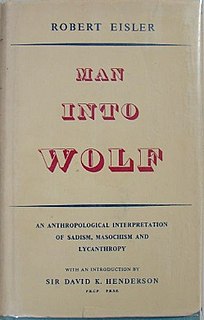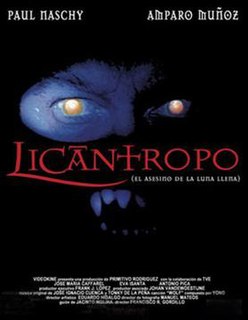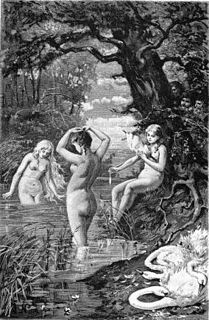This page is based on this
Wikipedia article Text is available under the
CC BY-SA 4.0 license; additional terms may apply.
Images, videos and audio are available under their respective licenses.

Werewolf fiction denotes the portrayal of werewolves and other shapeshifting man/woman-beasts, in the media of literature, drama, film, games, and music. Werewolf literature includes folklore, legend, saga, fairy tales, Gothic and Horror fiction, fantasy fiction and poetry. Such stories may be supernatural, symbolic or allegorical. A classic American cinematic example of the theme is The Wolf Man (1941) and in later films joins with Frankenstein's monster and Count Dracula, as one of the three famous icons of the modern day horror. However, werewolf fiction is an exceptionally diverse genre with ancient folkloric roots and manifold modern re-interpretations.
A wererat is a therianthropic creature in the shape of a rat.
The term is a neologism coined in analogy to werewolf, used in the fantasy or horror genre since the 1970s.
The concept has since become common in role playing games and fantasy fiction inspired by them. Were-rats are commonly portrayed as sewer-dwelling scavengers and opportunistic thieves. Brad Steiger has written about wererat sightings in Oregon, mostly by children.
A werewolf, in folklore, is a person who changes into a Wolf
Anthony Lupus is a fictional character in DC Comics.

Werewolf of London is a 1935 horror film directed by Stuart Walker and starring Henry Hull as the titular werewolf. It was produced by Universal Pictures. Jack Pierce's werewolf make-up was simpler than his version six years later for Lon Chaney, Jr. in The Wolf Man. Werewolf of London was the first Hollywood mainstream film to feature a werewolf. The film's supporting cast features Warner Oland, Valerie Hobson, Lester Matthews, and Spring Byington.

In Dungeons & Dragons, a lycanthrope is a humanoid shapeshifter based on various legends of lycanthropes, werecats, and other such beings. In addition to the werewolf, in Dungeons & Dragons, weretigers, wereboars, werebears and other shapeshifting creatures similar to werewolves and related beings are considered lycanthropes, although traditionally, "lycanthrope" refers to a wolf-human combination exclusively.

The Werewolf is a 1956, independently made, American low-budget science fiction horror film, produced by Sam Katzman and directed by Fred F. Sears, from a screenplay by Robert E. Kent and James B. Gordon. It stars Steven Ritch, Don Megowan, and Joyce Holden. The film score was composed by Mischa Bakaleinikoff.

La Maldicion de la Bestia is a 1975 Spanish horror film that is the eighth in a long series about the werewolf Count Waldemar Daninsky, played by Paul Naschy. The film has also been known as The Werewolf and the Yeti, Night of the Howling Beast and Hall of the Mountain King. This film ignored the events from the earlier films The Fury of the Wolfman (1970) and Curse of the Devil (1972), and provided an all-new origin for Waldemar's lycanthropy, having the curse transmitted by the bites of not one, but two, vampire women! A yeti is woven into the storyline, but in this film the yeti is not the cause of Waldemar's lycanthropy, but rather the catalyst that brings Waldemar to Tibet in the first place.
When one is said to cry wolf it is an expression that means to "raise a false alarm", derived from the fable The Boy Who Cried Wolf.

Man Into Wolf; An Anthropological Interpretation of Sadism, Masochism and Lycanthropy is a book by Robert Eisler, published in 1948. The text is based upon his readings in archeology and anthropology; anything not covered by these disciplines is then dealt with using Jungian methods of dream analysis and the theory of archetypes. For instance, his remarks concerning the nature of life in prehistory are largely derived from his interpretations of the dreams of psychotherapy patients.
Lawrence Stewart "Larry" Talbot, also known as The Wolf Man, is a title character of the 1941 Universal film The Wolf Man and its sequels. He was portrayed by Lon Chaney Jr. In the 2010 remake of the film, he is portrayed by Academy Award-winner Benicio del Toro. The Wolf Man was part of the Universal Monsters ensemble.

In mythology and literature, a werewoman or were-woman is a woman who has taken the form of an animal through a process of lycanthropy. The use of the word "were" refers to the ability to shape-shift but is, taken literally, a contradiction in terms since in Old English the word "wer" means man. This would mean it literally translates to "man-woman".











